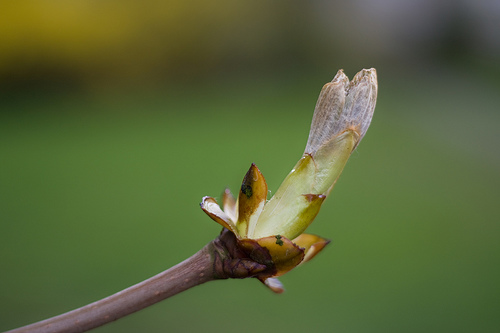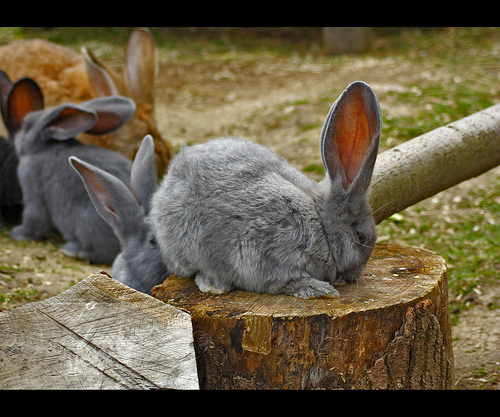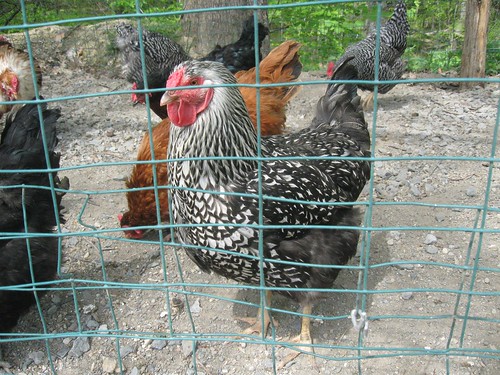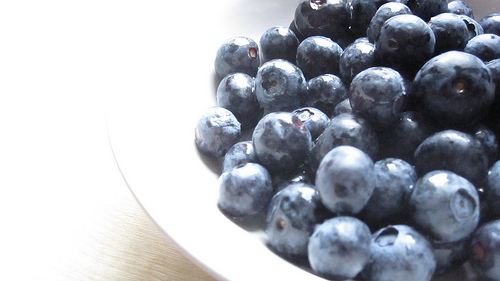Archive for April, 2010
Take the First Step

I found this photo from the first year here on our little suburban homestead. It was taken after my friend Rouge came over to grade and level the property, making the water drain properly. We had already removed about a dozen old, scraggy, ill cared for fruit trees that were planted haphazardly around the property, mangy Oleander bushes and a row of boxwood hedge that divided the property in half.
The photo is nothing special, just Brianne helping trench the barn waterline, raised beds and stakes outlining the footprint of the barn. But what it has lead to is six years of a working, prosperous backyard farm. In just a few years after this photo was taken we have built the barn (by hand) that now houses our livestock, planted gardens, bred rabbits, raised sheep, kept chickens, lived with mutts (Dakota and Dutch), danced to music at sunset, raised a kid and fell in love with the simpler things in life.
There were many times I had no idea what the hell I was doing; I taught myself as I went along, reading books in Borders over a steaming bowl of soup at lunch. I scoured the internet for forums of like-minded people. I joined clubs, made new friends, tapped old ones for information and techniques. We learned to eat from dirt and farm stands. We mostly eat at home now, but we go out to get what we need; out to the garden that is, to pick veggies and fruit and eggs. I can quilt now, build what I need, bake our own bread and sit down to share it all with you. But, the point I want to make is that things grew from the first small effort, and with steps taken it will bring you home.
Here we are today, with a freezer full of home grown lamb and chicken, handmade sausage and salami, berries, tomatoes, beans and peas. We get almost a dozen eggs a day. We’ve just hatched our own chicks – again. I know how to butcher a chicken from first cut to final wrap. I’m learning to collect rain water. Every year we learn and grow, becoming more self-sufficient thanks to this land.
A lot can happen if you make it. And it all starts somewhere. As the saying goes, “the journey of a thousand miles begins with the first step”. If you need proof, just look at the picture again. What was once barren, dry, and brown is lush and green and fruitful.
Make today the beginning of your journey. Just take that first step.
Foggy Morning, Sleeping Dogs
It’s a cold, foggy morning here on the farm. In a few minutes Brianne will be outside in the dusky morning feeding chickens and rabbits and sheep by the dim light of dawn, but right now I’m putting on the teapot and waking up the dogs. Dutch and Dakota are still curled up on their beds, not the least bit interested in my morning routine. I think they know it’s foggy and chilly outside and have no desire to rush out in it.
But dogs don’t feed sheep, nor do they collect eggs, so they can revel in the luxury of sleep for a little while longer. Brianne stumbles into the kitchen, bundled in a sweatshirt and warm pants, barely awake. She pulls the hood over her head so much that it buries her eyes. She grabs her gloves and out she goes. The routine of a farm, no matter what the size, goes on.
Enjoy your day folks, hope yours is warmer.
![]() photo credit: gogoloopie
photo credit: gogoloopie
Back to the Way Things Used to Be

I found this song on another blog and wanted to share it with all of you. It’s called Old Old fashioned, by the Scottish indie band, Frightened Rabbit. I love the meaning behind the words. I think it speaks to the way we are trying to live our lives – simply, uncomplicated. The lyrics are below so you can see for yourself. You can get more details of the band, and listen to their songs here.
I think this would be some great gardening music for the ipod.
Old Old Fashioned
I’ll turn off the TV
It’s killing us, we never speak
There’s a radio in the corner
It’s dying to make a scene
So give me soft, soft static
With a human voice underneath
And we can both get old fashioned
Put the brakes on these fast, fast wheels
Oh let’s get old fashioned
Back to how things used to be
If I get old, old fashioned
Would you get old, old fashioned with me?
Put the wall clock in the top drawer
Turn off the lights so we can see
We will waltz across the carpet
1-2-3-2-2-3
So give me the soft, soft static
Of the open fire and the shuffle of our feet
We can both get old fashioned
Do it like they did in ’43
Oh let’s get old fashioned
Back to how things used to be
If I get old, old fashioned
Would you get old, old fashioned with me?
So give me soft, soft static
We won’t need no electricity
If we both get old fashioned
We won’t have to rely on our memories
Oh let’s get old fashioned
Back to how things used to be
If I get old, old fashioned
Would you get old, old fashioned with me?
Listen to the song here by clicking this link. But, be forewarned, this isn’t a “family friendly” album. I wouldn’t consider listening with the kids in the car…
DIRT! The Movie

“Floods, drought, climate change, even war are all directly related to the way we are treating dirt.”
DIRT! The Movie–directed and produced by Bill Benenson and Gene Rosow–takes you inside the wonders of the soil. It tells the story of Earth’s most valuable and underappreciated source of fertility–from its miraculous beginning to its crippling degradation.
The opening scenes of the film dive into the wonderment of the soil. Made from the same elements as the stars, plants and animals, and us, “dirt is very much alive.” Though, in modern industrial pursuits and clamor for both profit and natural resources, our human connection to and respect for soil has been disrupted. “Drought, climate change, even war are all directly related to the way we are treating dirt.”
DIRT! the Movie–narrated by Jaime Lee Curtis–brings to life the environmental, economic, social and political impact that the soil has. It shares the stories of experts from all over the world who study and are able to harness the beauty and power of a respectful and mutually beneficial relationship with soil.
DIRT! the Movie is simply a movie about dirt. The real change lies in our notion of what dirt is. The movie teaches us: “When humans arrived 2 million years ago, everything changed for dirt. And from that moment on, the fate of dirt and humans has been intimately linked.” But more than the film and the lessons that it teaches, DIRT the Movie is a call to action.
“The only remedy for disconnecting people from the natural world is connecting them to it again.”
What we’ve destroyed, we can heal.
So much going on
There’s so much going on right now, on this homestead. It would take thousand of words to explain it all, and although I’ve love it if that were my primary gig it’s just not in the cards right now.
In farm news: we’ve had a wacky spring so far; wind and cold and rain so late in the season I can’t even remember the last time we had late April showers. The fire roars at night while the days claw their way into the low-60’s. My seedlings are not liking the cold at all and some of my spring planting has been pushed back waiting for warmer soil temps.
On the chick front, I think we will lose two of our chicks hatched last months. They’ve developed what’s called Merrick’s Disease and there’s nothing that can be done. The others are healthy and growing like weeds after a good rain. We moved some of the bigger one’s out to an old rabbit hutch because they were flying out of the brooder. I think the one’s that remain in the brooder will join their friends by next weekend. I’ve already chased three around the garage today.
On the up side though, Brianne’s show lambs are on their way, and we are excited to see what our friend found in his travels. This is a busy time of year for us with gardens and chickens and lambs and livestock shows, not to mention school and work. Our plate is so full we sometimes feel like crazed lunatics and a Vegas buffet.
May is just around the corner and if we’re lucky enough to get back into our normal weather patterns it’ll be game on. We’ll be working harder than ever to catch up and get this farm back on track. I can’t wait.
Bountiful Blueberries
Long before berries were touted for their health benefits and cancer fighting antioxidants I wanted my very own berry patch. Aside from melons, berries are my favorite fruit. Whether it be strawberries on pound cake with vanilla ice cream, blackberries or raspberries in fruit smoothies or blueberries hiding in my Saturday morning pancakes, berries are on my top ten list.
When I moved to my little homestead I vowed that I would have a berry patch, bursting with all of my favorites. It’s taken me awhile, but I finally have, what I think, is the perfect berry patch for a household of two. In the backyard I built two 3’x12’ raised beds. These beds hold the blackberries, Logan berries, red raspberries and golden raspberries. But, it’s the front yard that holds the stars of my lust for berries – BLUEBERRIES!!
After reading an article about edible landscapes I decided that the west facing front planter would be the perfect place for a living, edible hedge. So, two years ago I set out to make it happen. I laid the irrigation line, amended the soil with peat moss and well rotted compost. Blueberries like acidic soil that is rich in matter. When it came time to purchase my berry plants I talked to growers from the farmers market and local farm stands trying to get information about the best varieties for our area.
Then one day, while visiting a friend, I found out that one of my former neighbors had planted a 10-acre test plot with the idea of growing blueberries commercially. I gave Andy a call and picked his brain about growing conditions, fertilizing, watering, production, harvesting and, of course, varieties suitable for our area. It was a mini crash course in berry production and it was great. He was so helpful.
With a little more research on the internet to help me, I decided on two different varieties, three plants each. My new blueberry hedge would consist of O’Neal’s and Sharp Blue. They are both highbush type plants, which means they grow more vertically; perfect for my idea of growing an edible hedge. And, they mature different times of the year, so I would have a relatively consistent flow of berry goodness.
After a few phone calls I was able to find a local nursery that carried both varieties. On a beautiful spring day, under a crystal blue sky we drove the 10 miles to pick up our bushes. I had already told the nursery we were coming and what we wanted, but when we arrived we got the surprise of our lives. When the nursery workers went to the field to get our potted berries they found leftovers from previous seasons and brought them up front in case I might be interested. “Interested” I said, boy was I ever. These were not the ordinary spindly first year plants that home gardeners normally get, but 4-year-old plants that had been forgotten about at the back of the nursery. They were almost 3-feet tall and busting out of their pots.
I took the ones that looked the healthiest, loaded them in the truck and headed home feeling smug that we had gotten so much more than we anticipated. Once home, the planting went fast, and within a few hours the berries were nestled snuggly in their new home.
The harvest that first season was light – the results of transplanting and plant shock, which is normal. But, this season the plants were covered with tiny white flowers, a sign of things to come. The O’Neal’s will be harvested in June followed by the later maturing Sharp Blue. We should have enough berries for fresh eating, with plenty to freeze for winter use or for making into jam. No matter what, we will be in blueberry heaven.
If you see a blueberry patch in your future, check out these useful resources.
http://extension.oregonstate.edu/catalog/html/ec/ec1304/
http://www.motherearthnews.com/Real-Food/Growing-Blueberries.aspx
http://www.hgtv.com/landscaping/growing-blueberries/index.html
If you’re not ready to plant your own patch, buy fresh berries at the farmers market and enjoy their burst of flavor all season long. Pick up an extra pint and try this luscious recipe, one of our favorites from the Iroquois Hotel on Mackinac Island.
Blueberry-Lemon Muffins
(makes 18 large or 36 small muffins)
INGREDIENTS
2-2/3 cups all-purpose flour
1 Tbsp baking powder
1-1/2 tsp salt
2 eggs
1 cup milk
2/3 cup cooking oil
1-1/2 cups fresh or frozen blueberries
½ Tbsp lemon zest
GLAZE:
4 Tbsp butter
½ cup sugar
Grease or coat muffin tins. Preheat oven to 400 degrees.
Into a mixing bowl sift flour and other dry ingredients.
Into a small bowl crack and beat eggs with a wire whisk for 10 seconds. Add the milk and oil to eggs and stir to blend. Make a well in the flour and pour in the egg-milk mixture. Stir as little as possible to moisten the flour. Set the batter aside for a moment.
Combine blueberries with lemon zest, and fold the berry mix into the muffin mix. Again stir gently and as little as possible. Spoon batter into muffin tins to ¾-full.
Place muffin tins into oven and set the timer for 20 minutes. It may take an additional 5 minutes to become golden brown. Check at 15 minutes, and if they are browning too quickly, move to the bottom rack of the oven.
While the muffins are baking, melt butter in a small saucepan. Pour the sugar into a small shallow bowl easy for dipping.
When the muffins are finished, cool for 5 minutes. Run a knife around the edges of each. Tilt and gently lift each muffin from the tin.
Dip the top of each muffin lightly in the butter and then in the sugar. The muffins can be held overnight and reheated for eating. They can also be frozen, but fresh is always best.
The Season In Between

And so it’s here, what I call, The Season In Between. That weird and wonderful time in a California spring where the days are warm and sunny, but the evenings are cool enough that they cry out for a roaring fire. This creates highs and lows amongst us gardeners.
Do we plant? Don’t we plant? What could we plant? It’s an anxious time of wanting desperately to be out in the dirt, but knowing the cold could wipe us out in a single night. I pace and watch to see what the readings are on the thermometer outside my kitchen window. We are still into the 40’s at night – too cold for most veggies.
So here I am, with a kitchen full of sprouted vegetables in pony packs and flats and pots, just itching to be out growing in the dirt.
I came home to a relatively warm, and sunlight evening. It was about 52 degrees, the breeze was light, but the sun was out and I was tired of being locked up in four-walls with fluorescent lights. So I fixed a pot of tea, put on a heavy sweater, grabbed a gardening book and went outside to sit in the cool night air.
I have a cushion-lined Adirondack chair set at the far edge of the garden. It gives me a panoramic view of both the vegetable beds and the barn area. The evening was peaceful. Birds twittered and the hens scratched around in their yard. I left the backdoor open so the dogs could pad in and out from the warm fireplace to me.
It’s a weird twilight time of open doors, a fire inside, a cool west breeze, a waltz of chickens, and dogs milling about – all at the same time. With the chickens strutting about and the sheep in their paddock the whole farm seems to be stretching its arms into daylight savings. That deserves a few bird songs.
I hate how far away from October we are, and how long ago fall was. But to know the seeds of summer and a lot of change are getting planted, and that feels good – really good.
Fickle weather be damned.
![]() photo credit: Wanja Krah
photo credit: Wanja Krah
The Sun Hangs Low
Daylight savings time has given this farm a special gift. The extra hours of daylight allows enough time to let the chickens out in the garden every evening. For a few brief hours they can play and run, scratch in the dirt and dig for bugs. Then before I head back into the house, I move them all back into the safety of their little coop. Most of the winter they’ve been stuck inside since heavy rains turned their outside run into a pond. But now the rains have subsided and the water has retreated into the soil. The flock can run out in the open again. And, you should see them go – running around, well, like chickens with their heads cut off – flapping their wings and squawking like mad.
So, while Brianne is working her show lambs, I walk over to the coop, grab a handful of scratch, unlatch the door and entice them out. It doesn’t take much, before they are happily pecking and scratching at dropped bits of grain and hay on the barn floor. When I first open the coop door, the smaller bantams are reluctant, but the Blue Cochin (Blue Boy) makes a beeline for freedom, followed by three Arucana hens. In the end, even the timid girls venture out. Eventually, they all make it into the wide open world. I follow behind moving them toward the garden and out of sight of the sheep. Not that the sheep will do any harm, it’s just that the chickens are a distraction while Brianne is working her lambs.
This weekend saw days in the 60’s and is slowly absorbing what’s left of the standing water in the garden. I’ve started turning garden beds, and getting my early season veggies in. Lettuces, peas, broccoli, onions… (you get the idea.) But there is so much to do outside right now; the garden is constantly in the back of my mind.
Yesterday was a hard core farm day. We spent most of the afternoon working outside. We had to clean out old bedding in the chicken coop and replace it with fresh and the sheep pen needed to be raked out too. We hauled 50lb bags of sheep feed and lay mash over our shoulders. We moved the rack of firewood, that stands near the back door for easy access during rainstorms, to it’s off season location on the south side of the house. And when we weren’t doing intense physical labor we were tending to the early blooming flowers. We also collected eggs, checked on overall bird health and trimmed a few toenails and spurs. The lambs’ hooves were also trimmed and checked for signs of foot rot (a common condition in wet weather when there is standing water). We even managed to clean out the rabbit hutch and move all that glorious, nutrient rich manure to the compost pile. Needless to say, we came in from our long day dirty, sore and tired, but happy that we were able to accomplish so much. A long hot bath, a warm home cooked meal and good book enjoyed in a quiet room set us back on tract though.
It was all worth it.
I’ve got a pot of tea on now, and listening to the chicks in their box house beside me while I type is like a sweet symphony.
In a few moments I’ll go out to feed the dogs and refill the chicks’ water and food. But, for now, I think the dogs and I are going to sit here and enjoy some music and Earl Gray tea. It’s not like they haven’t been through this before. Enjoy your evening folks.





Recent comments
Aenean nonummy hendrerit mauris. Phasellus porta.